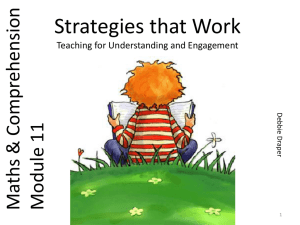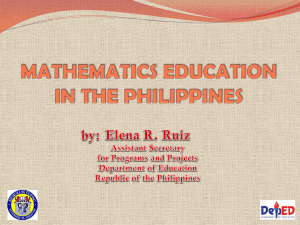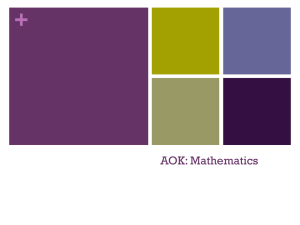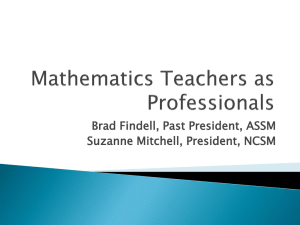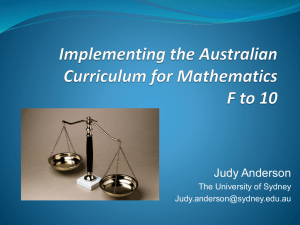Strategies that Work Teaching for Understanding and Engagement
advertisement
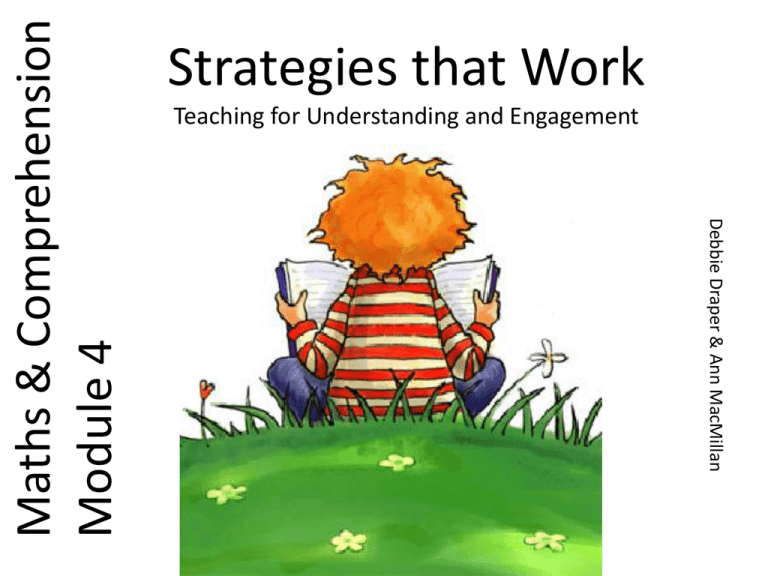
Teaching for Understanding and Engagement Debbie Draper & Ann MacMillan Maths & Comprehension Module 4 Strategies that Work Agenda 9:00 10:00 - 11:00 11:00 – 11:20 11:20 – 12:30 12:30 – 1:30 1:30 – 4:00 Mathematics and Integral Learning Properties of Number – vocabulary, practical applications and problem solving activities Break Properties of Number contd. Lunch Comprehension Strategies applied to Mathematics http://www.thenetwork.sa.edu.au/ Comprehending Math: Adapting Reading Strategies for Teaching Mathematics K-6 Arthur Hyde http://www.braidedmath.com/ • Deal out 5 cards to each participant • Arrange your five cards in order, starting with the card that best describes you, and ending with the one that is least like you • Now, you get a chance to discuss your immediate response to the cards you were dealt. Were there any you wanted to get rid of immediately? Any you weren't willing to part with? Would you be comfortable living your life out with the hand you were dealt? Negotiate… Theory Conceptual Connections Importance of Visualisation Research Overview Practical Strategies Practice Attitudes Making Connections Whole brain processing LEFT BRAIN • Logical • Sequential • Rational • Analytical • Objective • Looks at parts RIGHT BRAIN • Random • Intuitive • Holistic • Synthesizing • Subjective • Looks at wholes The theory of mathematics is important to me. I like to know what experts know. Understanding why is important to me. I need to visualise and connect. I like knowing the process and practising problems to get better. I need to know how it is relevant to my life. I like to be able to discuss different ways of solving the problem. Your story • Consider your educational experiences in mathematics • Share with people at your table • Be ready to share with the whole group Story Connection Attitudes Over to Ann Comprehension Strategies & Scaffolding Number Algebra Measurement Geometry Statistics Probability Discussing Using objects Re-enacting Drawing pictures Making lists / tables Connecting Questioning Inferring Visualising Determining Importance Summarising Synthesising Monitoring Understanding Questioning Common question in mathematics are... • Why do I have to do this? • What do I have to do? • How many do I have to do? • Did I get it right? Common question in mathematics should be.. • What do I do? • Why? • What other ways are there? There are two things in life we can be certain of..... Death, Taxes and Mathematics At least 50% of year 5’s hate story problems. They come to pre-school with some resourceful ways of solving problems e.g. dividing things equally. Early years of schooling – must do maths in a particular way, there is one right answer, there is one way of doing it. They are told what to memorise, shown the proper way and given a satchel full of gimmicks they don’t understand. Story Problems • Just look for the key word (cue word) that will tell you what operation to use Fundamental Messages • • • • • • • Don’t read the problem Don’t imagine the solution Ignore the context Abandon your prior knowledge You don’t have to read You don’t have to think Just grab the numbers and compute! What do I know for sure? What do I want to work out, find out, do? Are there any special constraints, conditions, clues to watch out for? What do I know? What do I want to work out? Are there any conditions or constraints? Problem Solving Questions • What is the problem? • What are the possible problem solving strategies? • What is my plan? • Implement the plan • Does my solution make sense? Up to 75 % of time may need to be spent on this stage A small plane carrying three people makes a forced landing in the desert. The people decide to split up and go in three different directions in search of an oasis. They agree to divide equally the food and water they have which includes 15 identical canteens, 5 full of water, 5 half full of water and 5 empty. They will want to take the empty canteens in case they find an oasis. How can they equally divide the water and canteens among themselves? Another way of looking at questioning in mathematics.... Yet another way of looking at questioning in mathematics.... Newman's prompts • The Australian educator Anne Newman (1977) suggested five significant prompts to help determine where errors may occur in students attempts to solve written problems. She asked students the following questions as they attempted problems. 1. Please read the question to me. If you don't know a word, leave it out. 2. Tell me what the question is asking you to do. 3. Tell me how you are going to find the answer. 4. Show me what to do to get the answer. "Talk aloud" as you do it, so that I can understand how you are thinking. 5. Now, write down your answer to the question. 1. Reading the problem Reading 2. Comprehending what is read 3. Carrying out a transformation from the words of the problem to the selection of an appropriate mathematical strategy 4. Applying the process skills demanded by the selected strategy 5. Encoding the answer in an acceptable written form Comprehension Transformation Process skills Encoding Read and understand the problem (using Newman's prompts) • Teacher reads the word problem to students. • Teachers uses questions to determine the level of understanding of the problem e.g. – How many pizzas are there? – Are the pizzas the same size? – Are both pizzas cut into the same number of slices? – Do we know yet how much the pizza weighs? An article about using Newman’s Prompts Conceptual Understandings Patterns • All branches of mathematics have characteristic patterns Mathematics - the Science of Patterns Trusting the Count Countable Unit: Ones Place Value Countable Unit: Tens • Subitising • Principles of counting • Part part whole relationships • • • • New unit – 10 ones is 1 ten Number names regular, irregular Counting with new unit Second place value system Additive to Multiplicative thinking • Countable Unit: Whole numbers • Concepts and strategies for addition/subtraction Factors, arrays, area models, Cartesian products, mental strategies Partitioning Proportional reasoning • Countable Unit: Rational numbers Countable Unit: Rational numbers • • Generalising Countable Unit: An unknown/variable • • • Fractions – concepts, naming, recording Decimal fractions Relative proportions Recognising patterns Modelling, predicting Expressing general case in words and symbols “Seeing” the value of the number by subitising “Naming” the value of the number by counting 7 or seven • Use of low level procedural tasks (75%) x Here it is 3 cm • Find x 4 cm • Leads to lack of conceptual understanding Ma and Pa Kettle Maths 2:14 http://www.youtube.com/watch?v=Bfq5kju627c Abbott And Costello 13 X 7 is 28 2:56 http://www.youtube.com/watch?v=Lo4NCXOX0p8 Concepts Patterning Models History of Mathematics 7:04 http://www.youtube.com/watch?v=wo-6xLUVLTQ Making Connections Concepts are abstract ideas that organise information Multiplicative thinking Multiplication facts Traditional Approach • • • • Explanation or definition Explain rules Apply the rules to examples Guided practice D E D U C T I V E Making Connections Maths to Self • What does this situation remind me of? • Have I ever been in a situation like this? Maths to Maths • What is the main idea from mathematics that is happening here? • Where have I seen this before? Maths to World • Is this related to anything I’ve seen in science, arts….? • Is this related to something in the wider world? What do I know for sure? What do I want to work out, find out, do? Are there any special constraints, conditions, clues to watch out for? Imagine that you work on a farm. The owner has 24 sheep tells you that you must put all of the sheep in pens. You can fence the pens in different ways but you must put the same number of sheep in each pen. What is one way you might do this? How many different ways can you find? Making Connections Maths to Self • What does this situation remind me of? • Have I ever been in a situation like this? Maths to Maths • What is the main idea from mathematics that is happening here? • Where have I seen this before? Maths to World • Is this related to anything I’ve seen in science, arts….? • Is this related to something in the wider world? What do I know for sure? Imagine that you work on a farm. The owner has 24 sheep tells you that you must put all of the sheep in pens. You can fence the pens in different ways but you must put the same number of sheep in each pen. What is one way you might do this? How many different ways can you find? What do I want to work out, find out, do? Imagine that you work on a farm. The owner has 24 sheep tells you that you must put all of the sheep in pens. You can fence the pens in different ways but you must put the same number of sheep in each pen. What is one way you might do this? How many different ways can you find? Are there any special conditions, clues to watch out for? Imagine that you work on a farm. The owner has 24 sheep tells you that you must put all of the sheep in pens. You can fence the pens in different ways but you must put the same number of sheep in each pen. What is one way you might do this? How many different ways can you find? Braid Model of Problem Solving Understand the problem • KWC • Making Connections Planning to solve the problem • What representations can I use? Solving the problem • Work on the problem using a strategy • Do I see any patterns? Checking for understanding • Does my solution make sense? • Is there a pattern that makes the answer reasonable? • What connections link this problem to the big ideas of mathematics? Visualisation in Mathematics • What does it mean to you? One of the main aims of school mathematics is to create in the mind’s eye of children, mental objects which can be manipulated flexibly with understanding and confidence. Siemon, D., Professor of Mathematics Education, RMIT Subitising (suddenly recognising) • Seeing how many at a glance is called subitising. • Attaching the number names to amounts that can be seen. • Learned through activities and teaching. • Some children can subitise, without having the associated number word. Make Materials Real-world, stories Perceptual Learning five Name Language read, say, write Record 5 Symbols recognise, read, write Making the Links Are we giving students the opportunity to make the links between the materials, words and symbols? Materials Symbols Think Board Picture Words MAKE TO TEN Being able to visualise ten and combinations that make 10 DOUBLES & NEAR DOUBLES Being able to double a quantity then add or subtract from it. Imagine that you work on a farm. The owner has 24 sheep tells you that you must put all of the sheep in pens. You can fence the pens in different ways but you must put the same number of sheep in each pen. What is one way you might do this? How many different ways can you find? Representations • Move from realistic to gradually more symbolic representation Number of pens 1 2 3 4 6 8 12 24 Number of sheep in each pen 24 12 8 6 4 3 2 1 Number of pens Number of sheep in each pen 1 24 2 12 3 8 4 6 6 4 8 3 12 2 24 1 equal factors row column arrays quantity total 24 2 columns 12 rows One factor The other factor 1 24 2 12 3 8 4 6 6 4 8 3 12 2 24 1 1 x 24 = 24 2 x 12 = 24 3 x 8 = 24 4 x 6 = 24 6 x 4 = 24 8 x 3 = 24 12 x 2 = 24 24 x 1 = 24 Visualise a point in space Visualise a different point in space Now imagine joining these points with an imaginary ruler and pencil Now imagine removing these points as they are stopping your “line” extending itself. Remove one point. Now he can escape but can only go in the same direction he is currently heading. Let’s call him Ray! Unfortunately Ray is a unidirectional character. He is still not happy. Ray is still not happy. He wants to be free to extend in both directions Remove the other point. Now Ray is happy but he has to change his name. He is now known simply as Line. Your turn • Make up a visualisation script about intersecting, perpendicular and parallel lines Mathematics reasoning requiring visualisation What connections are you making? What are you visualising? Visualising & Automaticity • An equilateral triangle is one in which all three sides and all three angles are equal. • An isosceles triangle has two equal sides and two equal angles • A right angled triangle has one of its angles equal to 90° • An acute triangle has each of its angles less than 90° • A scalene triangle has each side of a different length. • A triangle is considered an obtuse triangle if it has one angle greater than 90°. What other ideas do you have for developing automaticity in maths using visual techniques? What if the world only had 100 people? 1:31 http://www.youtube.com/watch?v=QCSLjGnIfUc Inference Sometimes all of the information you need to solve the problem is not “right there”. What You Know + What you Read ______________ Inference There are 3 people sitting at the lunch table. How many feet are under the table? What I Read: There are 3 people. What I Know: Each person has 2 feet. What I Can Infer: There are 6 feet under the table. 1. Read the question aloud 2. Ask students whether there are any words they are not sure of. Explicitly teach any words using examples, pictures etc. 3. Ask students to paraphrase the question 4. Ask students to make connections –have they shared something out when they are not sure how it will work out? Have you seen a problem like this before? When might this happen in real life? 5. What might the answer be or NOT be? Why? 6. Ask students to agree or disagree and explain why. 7. Re-read the information. Peta has some plums – we need to work out how many plums Peta has. Peta is giving some plums to her friends . We don’t know how many friends Peta has. 8. What else do we know and not know? 9. What can we infer? If she gives each friend 4 plums, she will have 6 plums left over What can you infer from this? Determining Importance Determining Importance Some students cannot work out what information is most important in the problem. This must be scaffolded through • explicit modelling • guided practice • independent work Solve this! Nathan was restocking the shelves at the supermarket. He put 42 cans of peas and 52 cans of tomatoes on the shelves on the vegetable aisle. He saw some tissues at the register. He put 40 bottles of water in the beverage aisle. He noticed a bottle must had spilled earlier so he cleaned it up. How many items did he restock? Strategy 42 cans of peas 52 cans of tomatoes tissues at the register 40 bottles of water water that he cleaned up important important not important important not important Summarising & Synthesising Journaling as a closure activity gives students an opportunity to summarise and synthesise their learning of the lesson. Use maths word wall words to scaffold journaling. Include words like “as a result”, “finally”, “therefore”, and “last” that denote synthesising for students to use in their writing. Or have them use sentence starters like ”I have learned that…”, “This gives me an idea that”, or “Now I understand that…” What do I now know for sure? How can I use this knowledge in other situations? What did I work out, find out, do? How did I work it out? Were there any special conditions? What conclusions did I draw? What facts did I learn? How did I feel? What went well? What problems did I have? What creative ways did I solve the problems? What connections did I make? How can I use this in the future? What is the rule? Draw it What connections do I know? Journal Show an example How does it relate to my life? A=LXW Area equals length multiplied by width Multiplication facts Arrays and grids One surface of some solids e.g. cylinder Same as 2 equal right angled triangles Journal A room has a length of 4 metres and width of 3 metres. The area is 4m x 3m = 12 sq metres Measuring material for a tablecloth Working out how many plants for my vegetable garden We now know a lot more about how children learn mathematics. Meaningless rote-learning, mindnumbing, text-based drill and practice, and doing it one way, the teacher’s way, does not work. Concepts need to be experienced, strategies need to be scaffolded and EVERYTHING needs to be discussed. Considerations • What is the concept or big idea I want students to understand? • To what prior knowledge should we try to connect? • Are there different models of the concept? • Is there a sequence of understanding that the students need to have? • What other mathematical concepts are related? Considerations • What are the different real life situations or contexts in which students would encounter the concept? • Will they see it in other curriculum areas? • How can I vary the contexts to build up a more generalised understanding? • What version of the situation can I present to start them thinking about the concept ? • What questions can I ask to engage and intrigue them?
